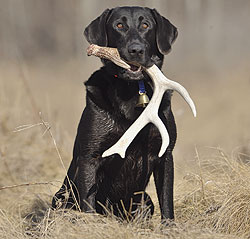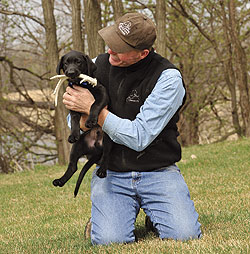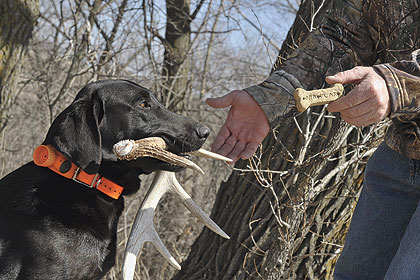Finding and retrieving shed deer antlers is a fun off-season activity for you and your dog.
By Jerry Thoms
Photography: Lee Kjos
When Gunner, a two-year-old black Labrador, came running up to Lee Christianson, his owner, everyone was amazed at what the dog was carrying. The big Lab had found a five-point whitetail deer antler while Gunner, Christianson, and two friends were on a walk through a park on the edge of Minneapolis, a 20-minute drive from Christianson's home. The shed antler probably was dropped by a big whitetail buck in late winter and was found on a spring day in early April.
"Man, were we surprised," Christianson recalls. "Gunner is our family's duck and pheasant dog. Hunting shed deer antlers was something new and different -- and something he apparently naturally wanted to do," Christianson says.
From that accidental beginning, Christianson went on to more formally teach his Lab to deliberately search for, pick up, and retrieve shed deer antlers -- often simply referred to as "sheds" -- by enrolling Gunner in a training program offered by Tom Dokken from Oak Ridge Kennels in Northfield, Minnesota.
"Using a gun dog or nearly any breed of canine to hunt for and fetch up shed deer antlers has become a growing sport that offers year-round exercise for physical conditioning and a good method to enhance the whole spectrum of hunting skills for upland birds as well as waterfowl," says Dokken.
"With some clear and simple training methods, most all breeds of hunting dogs, and many other breeds of canines, can be taught to become efficient shed antler finders," he adds. As a full-time professional dog trainer, Dokken has helped hundreds of hunting breeds become better upland gamebird and waterfowl dogs. And in recent years, he has developed a training program based on a series of simple steps all designed to teach any breed of dog to efficiently hunt for, find, and retrieve shed antlers.
Elementary Education
Puppies and older dogs not already introduced to retrieving can learn to look for and retrieve sheds by beginning their training program in the house with the same techniques used to teach the retrieving of gamebirds.
"In a narrow hallway or some other confined area of the house, slide a piece of shed antler across the floor, then let the pup or older dog chase it, pick it up, and bring it back to you," Dokken recommends. "Any tendency of the dog to be possessive with the antler and wander off is controlled by being in the restricted space, which compels the dog to return to the trainer.
"When the antler is returned, give exuberant praise, lots of petting, and a tasty treat so that the dog associates the positive rewards with going after and retrieving the antler," Dokken says. "A hot dog cut into dime-thin slices is a reward to which all canines will positively respond."
Any shape or size of antler will work as a training dummy, just so it is easy for a dog to pick up. "Trim off any long, sharp points so there is less chance of a dog's eye or mouth being poked," Dokken advises. "Because some old sheds can be dry and delicate, a newer one is usually stronger and longer lasting." To find an antler for training purposes, ask any ardent deer hunter if he has some he will give away. Or put an ad in the paper offering to buy any kind of deer antler for dog training.
 Tom Dokken has trained Rookie, a five-year-old Labrador retriever, to search for and fetch shed antlers. Though Labs are genetically programmed to retrieve gamebirds, most all breeds of dogs can be taught to retrieve antlers by following the training program Dokken has developed. |
Once a dog consistently chases down and fetches an antler thrown in the house, go outside into your yard for the next phase of training. "Initially toss the antler a few feet for short retrieves, then gradually extend the distance as long as the dog brings the antler to you," Dokken says.
If the dog decides to run off with the antler, use a 20- or 30-foot check cord attached to its collar and gently reel in the runner, again giving praise and a treat. "In most cases, most dogs will establish the habit of returning with the training antler," Dokken says.
Secondary Education
Once a dog will consistently retrieve an antler it sees thrown in the house and in the yard, the next step is to put an antler in a place where the canine nose must be used to find it. Bushes, tall grass, or piles of brush are typical locations in a large backyard or in a field that replicate the spots where sheds are often found in a natural setting.
"In the beginning, set out several training antlers in close proximity to each other so the first hunts are easily successful. Then expand the range of hiding places so more extensive searches are necessary. And, of course, continue praise, petting, and treats as rewards," Dokken reiterates.
"Be sure to mark the hidden antlers with some thin, lightweight plastic surveyor's tape or short pieces of colored yarn in any bright color so you can guide your dog in the right direction for the initial part of these first searches," Dokken suggests. "No, the dog won't see the tape or yarn because canines are color blind. So the markers work mainly to help the trainer keep track of this training tool.
"Continue the yard or field exercises with multiple hidden antlers until your dog regularly finds them and identifies the shed hunt as a special experience," Dokken continues. "A few weeks of repeated and successful shed hunts twice a day will train most all dogs to use their nose to find antlers wherever they are hidden."
At this stage in training, an effort should be made to keep the human scent off the antlers used in the training process. "I recommend storing antlers out in the open where sun and wind will reduce human odor," Dokken says. "And when handling antlers to be used in a training session, the trainer should wear latex gloves to cut back on contaminating the horns with the smell of human hands."
To further reduce human odor, Dokken recommends using a commercially-made scent-killer in a spray can that can be used to dissolve most of the odor that human hands can leave on antlers.
 One of the first steps to training any dog to hunt for shed antlers is to praise a pup for picking up and bringing in a shed used as a training tool. |
Higher Education
In the next stage of training, Dokken recommends setting up several sheds in a variety of typical natural locations then leaving them undisturbed for several days. "The idea here is to re-create the actual circumstance of sheds found in the wild with all human scent removed," Dokken says. Again, be sure to use some brightly colored surveyor's tape or colored yarn so the sheds can be easily located by the trainer. Drawing a map with the sheds indicated can also be very helpful.
In this phase of training, the e-collar with a beeper/locator can be introduced as a way to control a dog's range and keep track of a dog in the field. "For most dogs, a mild nick can keep them from pottering or from running wild. And a beeper will be essential in locating any dog hunting in heavy cover such as thick stands of trees or tall prairie grass," Dokken points out.
Keep Your Hunter Tuned
Continuing education involves keeping a trained shed hunter in practice for finding antlers anywhere. This is something that can be done on every trip to the field simply by using the basic training tools with which the dog and its handler are already familiar.
"Always take some antlers along on each hunt so that, even if no new sheds are found, the old ones can be set out to ensure success and to maintain enthusiasm," Dokken recommends.
Likewise, work every dog with the e-collar to control hunting range, especially getting out too far, and to discourage unwanted behavior, such as chasing squirrels and rabbits.
"Be sure to regularly operate the beeper/locator so the dog is accustomed to the sound," Dokken advises.
When returning to an area often used for training, do change the location of set-out sheds so each trip to the place presents a different scenario for the dog. "If training sheds are put in the same place most dogs will soon learn to look there. Therefore, change the places each time to create a continuing challenge," Dokken says.
By following these steps, most all hunting dogs and many other breeds of dogs can become efficient hunters of shed deer antlers. "And, no, teaching a gun dog to search for and retrieve antlers will not interfere with hunts for upland gamebirds or waterfowl," Dokken emphasizes. "Feathers will still have priority over antlers as the main objective. But when an antler is found, do expect a trained shed hunter to bring it to you."
Where to Look
Deer yards and game trails are logical locations for finding shed deer antlers. The "yards" are places where bucks hang out mainly during the mid-winter months as a way to escape the harsh elements and roaming predators. Many deer yards are buried in thick, secluded, hard-to-get-to stands of trees, agricultural fields, open grasslands, and even suburban park areas. During these deer yarding times and in these places, bucks will drop antlers and that is where antler hunting dogs can find them.
Game trails, used by deer nearly anywhere, are also likely spots to look for sheds.
 When teaching any dog to be a shed hunter, the trainer can use praise and treats as rewards for good performance. |
Veteran shed hunters recommend close scrutiny of game trails with fence-lines that bucks jump over, in the process dislodging antlers that need only a little physical jolt to fall.
Likewise, game trails with overhanging tree branches are possible ways for antlers to get caught and knocked loose from a buck's head.
Other places to find shed antlers include much used feeding areas such as food plots planted specifically for wildlife. Bedding areas are also good sites to search for sheds because bucks spend so much time there. Deer left undisturbed by hunters and predators will often continually use specific bedding locations in trees as well as grasslands.
Conservation Reserve Program grasslands, which cover millions of acres in many states across the country, provides bedding spots for thousands of buck deer. Finding bedding areas is much easier and more efficient with the help of a shed hunting dog capable of covering many miles of this vast habitat.
What to Expect
Do expect most trained shed antler hunting dogs to search for shed antlers at every opportunity and on every trip into the field. But do not count on finding something on every hunt unless you are working areas much used by bucks throughout the year.
Location matters the most on a shed hunt. And though randomly chosen spots may occasionally produce some final products, the best odds on success come from looking in the most likely places.
Timing is a key factor in shed hunting success with late winter and early spring as the best times to be in the fields and forests. Shed antlers are the most plentiful then and, because freshly dropped, probably have the strongest detectable odor. Other times, however, shouldn't be ignored because antlers are always out there somewhere if they are in places where mice, squirrels, and other creatures won't chew them or otherwise destroy them.
The possible hazards of hunting sheds are no different from any other kinds of hunting except that in the spring and summer ticks and other insects may be more plentiful than in the fall and winter. Likewise, the prospects of a big-running dog getting lost on a shed hunt are similar to a bird hunt, so an e-collar with a beeper/locator, as already mentioned, may help to reduce this hazard.
Who Can Hunt For Sheds
Hunting for shed antlers requires no license, no major expenditures for gear, and no restrictions on where shed hunters can go, though permission might be required to trespass on some public land and is necessary for almost all private property.
There is no standard legal season for shed hunting; however, late winter and early spring are the best times to find fresh fallen antlers. No rules exist on who can hunt for shed antlers, so the experience is open to anyone with an interest no matter what their age, background, or expertise. These are all factors that makes shed hunting a good family activity because everyone, including the family dog, can do it.
As always, however, be sure to check your local regulations before shed hunting, especially on public lands. In some areas, such as certain wildlife management areas, removing shed antlers is prohibited, so make sure it is legal to pick up and retain the sheds before you -- or your dog -- do so.






